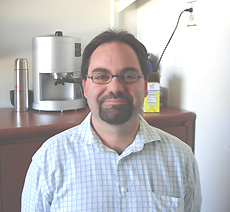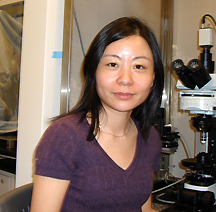 |
|
Roberto
Weigert
|
Roberto Weigert started working at NIH full-time six years ago, in NHLBI. He now leads his own lab in the Intracellular Membrane Trafficking Unit of NIDCR in building 30.
His focus is on understanding the molecular mechanisms regulating membrane traffic and protein secretion in salivary glands.
Hundreds of proteins are likely implicated, and few are known, he says, making this a field ripe for discovery.
Understanding these mechanisms may have an immediate relevance to the design of strategies to cure two of the major disorders affecting salivary glands: Sjögren’s syndrome, an autoimmune disease affecting millions of Americans, predominantly women, in which the body’s immune system attacks moisture-producing glands; and the damage induced by radiation treatment for head and neck cancer.
The field has progressed much since Pavlov’s day, mainly through research with cell-culture models. Weigert is transitioning to three-dimensional systems and live organisms using two-photon microscopy.
By exposing the salivary glands of living rats, his group can penetrate several hundreds of micrometers into the tissue to obtain a subcellular view of the intracellular organelles.
"With a cell culture, at some point you ask, ‘Is this physiologically relevant,’" Weigert said. "We are now looking at cellular events in their physiological context and we see clear differences from the tissue-culture models."
It
is known that saliva is first produced in acinar cells and is then transported
through ductal cells. Weigert’s group is narrowing in on how secretory
proteins are stored in granules and transported to the apical plasma membrane,
as well as how proteins and nutrients are delivered and transported from
the cell surface to inside the cell. One goal is to elucidate the molecular
mechanisms regulating both exocytic and endocytic events in mammalian
cells. ![]()
 |
|
Zheng
Li
|
Zheng Li is studying synaptic plasticity, or how the connections between neurons change in strength and how this change is related to cognition and neurological disorders. She joins the Genes, Cognition and Psychosis Program of NIMH after five years as a postdoc at the Massachusetts Institute of Technology in Cambridge.
During her postdoc, Li discovered that apoptotic molecules mediating programmed cell death can be activated in normal healthy neurons by electrical stimulations that cause long-term synaptic depression.
Li is investigating how the cell-death mechanism is involved in the decrease in synaptic transmission seen in develeopmental, cognitive, and neurological disorders, with an emphasis on schizophrenia.
Hundreds of proteins are involved in the action of a single synapse, and the details of this protein regulation are largely unknown.
Li’s lab in Building 35 uses molecular and cellular biology, live imaging, and electrophysiological techniques to study the electrical and chemical signaling occurring in the hippocampus and other brain slices of rats.
The hippocampus is involved in memory, emotion, and spatial navigation and is one of the first regions of the brain damaged in Alzheimer’s disease.
By
taking a "bottom’s up" approach of searching for the protein
interaction in synapses, Li hopes to contribute to the understanding of
how and why synapses wither. Her most recent work entails the nonapoptotic
role for caspase-3 in long-term depression and AMPA receptor internalization
in hippocampal neurons. ![]()